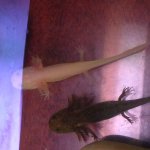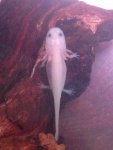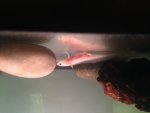ickeygooey
New member
- Joined
- Apr 4, 2016
- Messages
- 8
- Reaction score
- 1
- Points
- 0
- Location
- Rochester, New York
- Country
- United States
My friend and I bought two axolotls on April 2nd, they're just under two inches I believe. They are unable to house theirs at the moment so I am holding them both in a 10 gallon tank I had kept running with live plants after rehoming my fish (it has been thoroughly cleaned). Ammonia, nitrates, nitrites all read zero and their tank stays a steady 63 degrees. I just got a fan to set up to blow across the surface of the tank so hopefully that brings it down a couple degrees.
Both axies are active and interested in food, but the leucistic one doesn't always bite with enough force or enthusiasm to eat. They open their mouth but don't suck in any water, and when they do snap they usually spit out their food. I spend a lot of time wiggling individual bloodworms in front of them to get them to eat even just three or four. Just today they seemed to have formed lumps on their sides and look like they may be a little bloated? They seem very skinny for their size so I wonder if the lumps are just food because they seem to be moving around their body.
I also found a piece of gravel in the tank this morning which definitely was small enough for them to swallow, I don't know what axolotl it came from but it was not originally in my tank so I think that one of them may have passed it. We don't know what conditions they were living in before we got them. The leucistic one has a dark circle in their chest which could just be guts or food but I am unsure and worried it could be another rock. They pooped while I typed this and were receptive to live brine shrimp yesterday (well rinsed), I'm going to continue to try and feed them live foods with some frozen bloodworms.
I attached some pictures from earlier and two I took today. It looks like, from the pictures, that the black dot is moving around in their body so that may have been a rock? If it is, I have only ever seen the one. I can't find any clear answers from looking at other pictures of baby axolotls.
During the time I wrote this the lumps seemed to have gone away? It may have been food or maybe even air bubbles but I think its still worth leaving in this post.
I am very new to caring for axolotls and I have looked up as much information as I can on this but I cant find any information relating to these circumstances, and getting confirmation is always helpful! Thank you for reading, I hope we can figure this out and get this little guy eating again.
Both axies are active and interested in food, but the leucistic one doesn't always bite with enough force or enthusiasm to eat. They open their mouth but don't suck in any water, and when they do snap they usually spit out their food. I spend a lot of time wiggling individual bloodworms in front of them to get them to eat even just three or four. Just today they seemed to have formed lumps on their sides and look like they may be a little bloated? They seem very skinny for their size so I wonder if the lumps are just food because they seem to be moving around their body.
I also found a piece of gravel in the tank this morning which definitely was small enough for them to swallow, I don't know what axolotl it came from but it was not originally in my tank so I think that one of them may have passed it. We don't know what conditions they were living in before we got them. The leucistic one has a dark circle in their chest which could just be guts or food but I am unsure and worried it could be another rock. They pooped while I typed this and were receptive to live brine shrimp yesterday (well rinsed), I'm going to continue to try and feed them live foods with some frozen bloodworms.
I attached some pictures from earlier and two I took today. It looks like, from the pictures, that the black dot is moving around in their body so that may have been a rock? If it is, I have only ever seen the one. I can't find any clear answers from looking at other pictures of baby axolotls.
During the time I wrote this the lumps seemed to have gone away? It may have been food or maybe even air bubbles but I think its still worth leaving in this post.
I am very new to caring for axolotls and I have looked up as much information as I can on this but I cant find any information relating to these circumstances, and getting confirmation is always helpful! Thank you for reading, I hope we can figure this out and get this little guy eating again.





